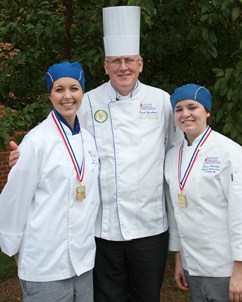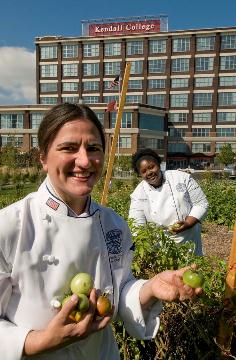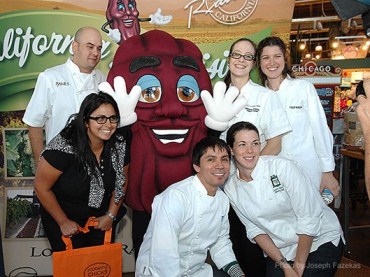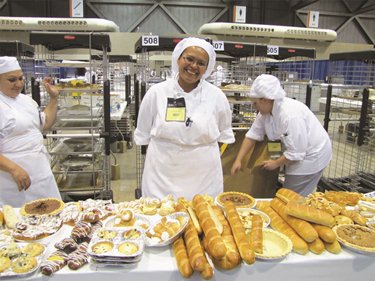The French Culinary Institute at The International Culinary Center to Release The Fundamental Techniques Of Classic Bread Baking for Home Bakers November 1
 For those who have always wanted to learn the art of bread baking, The French Culinary Institute’s November 1 release of The Fundamental Techniques of Classic Bread Baking (Stewart, Tabori & Chang, 2011, ISBN: 978-1-58479-934-4, $65.00/Can. $75.00) is the perfect cookbook. An indispensable addition to any serious home-baker’s library, The Fundamental Techniques of Classic Bread Baking is a glimpse into the exclusive French Culinary Institute’s intensive 12-week bread-baking course. Created in 1997, this course is taught by some of today’s greatest artisanal bread bakers and regarded as one of the top programs in the world.
For those who have always wanted to learn the art of bread baking, The French Culinary Institute’s November 1 release of The Fundamental Techniques of Classic Bread Baking (Stewart, Tabori & Chang, 2011, ISBN: 978-1-58479-934-4, $65.00/Can. $75.00) is the perfect cookbook. An indispensable addition to any serious home-baker’s library, The Fundamental Techniques of Classic Bread Baking is a glimpse into the exclusive French Culinary Institute’s intensive 12-week bread-baking course. Created in 1997, this course is taught by some of today’s greatest artisanal bread bakers and regarded as one of the top programs in the world.
The first half of the book introduces the reader to terms, basic techniques and “The Fourteen Steps of Bread Making.” Armed with this knowledge, readers are then given step-by-step instructions (with photos) to classic recipes for French, Italian, German, Middle European and gluten-free breads. Ranging from the familiar (straight baguette) to haute cuisine (carta di musica), this title is encyclopedic in both scope and format. Among its 352 pages are 300 color photographs.

 Demonstration Hall on the campus of Michigan State University was the site of a world record-breaking line of—believe it or not—tacos. And two students in The School of Hospitality Business demonstrated their perseverance, persuasive powers and organizational skills by spending nearly eight months orchestrating the memorable event, which occurred on September 30 and fulfilled the Guinness Book of World Records requirements.
Demonstration Hall on the campus of Michigan State University was the site of a world record-breaking line of—believe it or not—tacos. And two students in The School of Hospitality Business demonstrated their perseverance, persuasive powers and organizational skills by spending nearly eight months orchestrating the memorable event, which occurred on September 30 and fulfilled the Guinness Book of World Records requirements. Two students at Sullivan University’s National Center for Hospitality Studies (NCHS) won gold medals at the 2011 Music City Challenge, the American Culinary Federation-sponsored competition that took place September 27 and 28 in Nashville.
Two students at Sullivan University’s National Center for Hospitality Studies (NCHS) won gold medals at the 2011 Music City Challenge, the American Culinary Federation-sponsored competition that took place September 27 and 28 in Nashville. Kendall College has named Gwen Hillesheim, Ed.D., as provost. In this role, Hillesheim will serve as the academic leader of the Chicago-based institution that offers degrees in business, culinary arts, early childhood education and hospitality management. She replaces Dr. Karen Gersten, president of Kendall College, who served as provost for the last four years.
Kendall College has named Gwen Hillesheim, Ed.D., as provost. In this role, Hillesheim will serve as the academic leader of the Chicago-based institution that offers degrees in business, culinary arts, early childhood education and hospitality management. She replaces Dr. Karen Gersten, president of Kendall College, who served as provost for the last four years. Project Reinvent, the Idaho Potato Commission’s (IPC) popular foodservice advertising campaign, was the recent recipient of Produce Business’ 23rd Annual Marketing Excellence Award. It was one of 20 campaigns recognized by the magazine.
Project Reinvent, the Idaho Potato Commission’s (IPC) popular foodservice advertising campaign, was the recent recipient of Produce Business’ 23rd Annual Marketing Excellence Award. It was one of 20 campaigns recognized by the magazine. Kendall College is pleased to announce that Heidi Hedeker, MA/MSW, CEPC, a baking & pastry instructor and assistant professor in the School of Culinary Arts, has joined the advisory board of Chicago Lights Urban Farm in Chicago. Hedeker, who has a master’s degree in social work from the University of Chicago, has worked with Urban Farm since 2009 to develop and deliver educational programming for families in the Cabrini-Green neighborhood as well as students enrolled in nearby schools.
Kendall College is pleased to announce that Heidi Hedeker, MA/MSW, CEPC, a baking & pastry instructor and assistant professor in the School of Culinary Arts, has joined the advisory board of Chicago Lights Urban Farm in Chicago. Hedeker, who has a master’s degree in social work from the University of Chicago, has worked with Urban Farm since 2009 to develop and deliver educational programming for families in the Cabrini-Green neighborhood as well as students enrolled in nearby schools. As the nation celebrates Hispanic Heritage Month, The Culinary Institute of America (CIA) is pleased to announce the creation of a new culinary-certificate program focusing on Latin Cuisines. The two-semester (30-week) program will welcome its first class of students on January 24, 2012, at the college's campus in San Antonio, Texas. The advanced program is for CIA graduates and other industry professionals with culinary-arts degrees or certificates.
As the nation celebrates Hispanic Heritage Month, The Culinary Institute of America (CIA) is pleased to announce the creation of a new culinary-certificate program focusing on Latin Cuisines. The two-semester (30-week) program will welcome its first class of students on January 24, 2012, at the college's campus in San Antonio, Texas. The advanced program is for CIA graduates and other industry professionals with culinary-arts degrees or certificates. Pastry amateurs from all corners of Chicago and beyond gathered at the Whole Foods Market in Lincoln Park on September 17 to test their baking skills in Pastry Chicago’s Fourth Annual Pie Competition. Sponsored by the California Raisin’s Marketing Board, the 23 contestants submitted their favorite recipes for Fruit and Raisin Pies to the judges, including several Chicago pastry chefs. While pies were sliced and votes were tallied, Chef Della Gossett, chef instructor at The French Pastry School of Kennedy-King College, made one of her favorite pies for an audience with standing room only.
Pastry amateurs from all corners of Chicago and beyond gathered at the Whole Foods Market in Lincoln Park on September 17 to test their baking skills in Pastry Chicago’s Fourth Annual Pie Competition. Sponsored by the California Raisin’s Marketing Board, the 23 contestants submitted their favorite recipes for Fruit and Raisin Pies to the judges, including several Chicago pastry chefs. While pies were sliced and votes were tallied, Chef Della Gossett, chef instructor at The French Pastry School of Kennedy-King College, made one of her favorite pies for an audience with standing room only. As Navajo Technical College in Crownpoint, N.M., has been taking leaps and bounds toward national acclamation, the NTC culinary-arts program has taken its first steps toward national accreditation.
As Navajo Technical College in Crownpoint, N.M., has been taking leaps and bounds toward national acclamation, the NTC culinary-arts program has taken its first steps toward national accreditation.